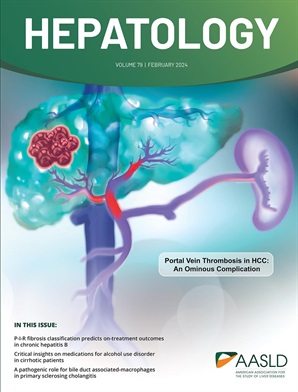塔塔盒结合蛋白相关因子2 (TAF2)在肝细胞存活和肿瘤发生中的作用
IF 12.9
1区 医学
Q1 GASTROENTEROLOGY & HEPATOLOGY
引用次数: 0
摘要
染色体8q扩增是包括肝细胞癌(HCC)在内的癌症中常见的事件。TATA-box结合蛋白相关因子2 (TAF2)是位于8q24.12的转录因子IID (TFIID)的一个组成部分,在HCC中被扩增。到目前为止,TAF2在HCC中的潜在致癌功能尚未被证实。我们在人类HCC细胞和组织样本中发现与正常细胞和组织样本相比,TAF2 mRNA和蛋白过表达。TAF2水平与HCC患者总生存率呈显著负相关。通过肝细胞特异性条件敲除小鼠(Taf2ΔHEP)、TAF2敲除和过表达的人HCC细胞以及通过流体动力学方法在小鼠肝脏中过表达TAF2来检测TAF2在HCC调节中的作用。作为基础转录机制的核心组成部分,TAF2是肝细胞生存所必需的。因此,在Taf2ΔHEP小鼠中存在肝细胞死亡和代偿性增殖,有助于形成有利于HCC的炎症/纤维化环境。因此,与野生型小鼠相比,Taf2ΔHEP小鼠中n -亚硝基二乙胺(DEN)/高脂肪高糖饮食诱导的HCC显著增加。小鼠肝脏中TAF2过表达不会导致肿瘤发展,但会显著增加驱动癌基因MYC过表达诱导的HCC。TAF2通过结合肿瘤促进基因和非编码rna的启动子并调节其转录,增强了人类HCC细胞中的癌症标志。因此,TAF2在肝细胞存活和肿瘤发生中起着独特而核心的作用。本文章由计算机程序翻译,如有差异,请以英文原文为准。
TATA-box binding protein associated factor 2 (TAF2) in hepatocyte survival and tumorigenesis
Chromosome 8q amplification is a frequent event in cancers including hepatocellular carcinoma (HCC). TATA-box binding protein Associated Factor 2 (TAF2), a component of Transcription Factor IID (TFIID) residing in 8q24.12, is amplified in HCC. As yet, a potential oncogenic function of TAF2 in HCC has not been documented. We identified TAF2 mRNA and protein overexpression in human HCC cells and tissue samples, compared to their normal counterparts. A significant negative correlation between TAF2 levels and overall survival of HCC patients was observed. The role of TAF2 in HCC regulation was examined using a hepatocyte-specific conditional knockout mouse (Taf2ΔHEP ), TAF2 knockdown and overexpressing human HCC cells, and TAF2 overexpression in mouse liver by hydrodynamic approach. As a core component of basal transcription machinery, TAF2 is required for hepatocyte survival. As such, in Taf2ΔHEP mice there were hepatocyte death and compensatory proliferation, contributing to an inflammatory/fibrotic milieu favoring HCC. Accordingly, N-nitrosodiethylamine (DEN)/high fat high sugar diet-induced HCC was robustly augmented in Taf2ΔHEP mice compared to their wild-type littermates. TAF2 overexpression in mouse liver did not lead to tumor development, but significantly augmented HCC that was induced by overexpression of the driver oncogene MYC. TAF2 augmented cancer hallmarks in human HCC cells by binding to the promoters of tumor promoting genes and non-coding RNAs and regulating their transcription. Thus, TAF2 plays a unique and central role in hepatocyte survival and tumorigenesis.
求助全文
通过发布文献求助,成功后即可免费获取论文全文。
去求助
来源期刊

Hepatology
医学-胃肠肝病学
CiteScore
27.50
自引率
3.70%
发文量
609
审稿时长
1 months
期刊介绍:
HEPATOLOGY is recognized as the leading publication in the field of liver disease. It features original, peer-reviewed articles covering various aspects of liver structure, function, and disease. The journal's distinguished Editorial Board carefully selects the best articles each month, focusing on topics including immunology, chronic hepatitis, viral hepatitis, cirrhosis, genetic and metabolic liver diseases, liver cancer, and drug metabolism.
 求助内容:
求助内容: 应助结果提醒方式:
应助结果提醒方式:


